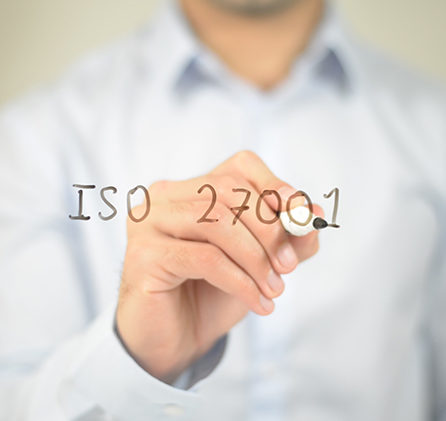ISO 27001 policies and procedures are an important part of establishing the requirements of the ISO 27001 Standard. Your business needs to make sure it can demonstrate well-organised documentation control and implementation of the ISO 27001 Standard. How? A series of security controls form part of the continual improvement process, this is essential for ISO 27001 compliance.
The ISO 27001 Standard provides businesses with a framework to manage information security across all areas of the business. It helps to safeguard your business against the threat of cyber-attacks and is compliant with legislation that protects any personal data and business information.
So, how can you do this effectively? Establishing an information security management system (ISMS) that is effective and documents all the policies and procedures that will protect your organisation. So, let’s take a deeper dive into the different ISO 27001 policies and procedures, explaining how and why your business should implement them to ensure the best protection for your business.
Why are ISO 27001 policies and procedures important?
Documenting your processes and procedures is essential for compliance with the ISO 27001 Standard. Without this, your business won’t meet the requirements needed to achieve ISO 27001 certification.
It’s important that your business has policies, processes and procedures in place that align with the control sets outlined in the Standard’s criteria. The latest changes to the structure of ISO 27001 mean there are 93 different security controls, divided into four themes, people, organisational, technological and physical.
Applying these controls effectively will provide your business with the platform to create an ISMS that is effective and compliant for certification.
What are the different ISO 27001 policies and procedures?
As with any ISO Standard, some policies and procedures need to be in place to govern the practices of your business and demonstrate compliance. The policies and procedures for ISO 27001 are listed in the Information Security Controls Reference from Reference Control Objectives and Controls, formerly known as Annex A.
Although not all 93 controls need to be implemented to demonstrate compliance. here are a series of mandatory policies and procedures that all businesses should aim to implement. Let’s analyse a few of these essential policies and procedures in further detail.
Information security policies
The first category outlined corresponds to information security policies. Basically, these are policies that your business needs to implement to comply with government regulations to protect the security of your business.
Contained within this control are guidelines for how to implement security controls, how to communicate them and the review procedures needed to ensure they are practical and applicable to the needs of your business.
As legislation changes and cyber threats become more complex, it’s important to adhere to a process of continuous improvement by regularly updating and reviewing your information security policies.
Your information security policies should be formatted similarly, and cover the following areas:
- What activities does the policy cover? Do your policies incorporate strategy, any current legislation in place and the current security threat of the business?
- What are the measures implemented by management to ensure compliance with the policy?
- What are the responsibilities of employees concerning the use of data? Who is responsible for overseeing any changes and reviews of ongoing policies around data protection?
Policies for employee responsibilities
To ensure your policies are maintained effectively, you should establish a series of policies and procedures that stipulate the responsibilities of employees in following the security policies of your business.
This should include things like awareness and training for employees, so they understand what to consider and report on. It should incorporate a disciplinary process for employees in the event of any security breaches.
Access control policy
This policy outlines how information is accessed and shared. It’s essential to consider the type of information that is accessible throughout your business, and if any controls need to be implemented to control who can access certain types of documentation.
To discover more information on every control outlined in the updated ISO 27001:2022 Standard, visit our webpage dedicated that details all of the 93 ISO 27001 controls in detail.
The ISO 27001 implementation process explained
You’ll need to ensure you have determined a process for implementing the policies, processes and procedures for your ISMS. To do so effectively, there should be a specialist implementation team who can oversee all aspects of this process.
Initially, the project team should outline a series of questions that the implementation should answer. These can include questions on what the aim of the controls are, the timeframe for implementation, costs to the business and what managerial support will be offered.
From there, your implementation team will be able to formulate specific policies to identify roles and responsibilities and how the terms of continual improvement will be met.
The Plan-Do-Check-Act strategy is the process approach adopted to ensure this, and this can be tailored to meet the needs and requirements of your business. There will also need to be an ISMS policy determined, which outlines how your implementation team will achieve this.
The overall structure may look something like this:
- Policies that outline the position of the business.
- A series of procedures that aid the requirements of the policies.
- Work instructions with specific employee guidelines.
- A series of documented records to track the progress of each.
Check out our dedicated webpage to find out more information on the ISO 27001 implementation process and the potential cost of ISO 27001.
Is there an ISO 27001 risk management process?
Arguably the most integral part of the ISO 27001 Standard and your ISMS is the risk management process that you implement. ISO 27001 allows you to establish your risk management process. This could be a specific asset that is exposed to risk within your business, or a scenario that presents risk.
You should ensure the following processes are maintained within your risk management strategy:
- Establishing the framework of your risk assessment.
- Identifying, analysing and evaluating all risks.
- Determining the options to manage risks effectively.
You will also need to categorise each risk and assess the impact of the risk on your business, with a hierarchical risk acceptance approach that details a series of criteria that is followed to help manage each risk individually but effectively.
Managing your ISO 27001 Standard with Citation ISO Certification
If your business needs a helping hand to gain certification of the ISO 27001 Standard, then Citation ISO Certification can help. We can help create a bespoke information security management system for you to ensure your business meets all the requirements of ISO 27001.
By partnering with Citation ISO Certification, you’ll also gain access to our bespoke Atlas Hub management system. You can use it to store, view, update and manage your ISMS with an easy-to-use dashboard tailored to your business requirements.
We also now offer certification to ISO 27001:2022, which includes all the latest changes and reviews to the ISO 27001 Standard. Check out our blog post here.
So, all this sounds great, right? Well, why not request a quote today, or contact our friendly, professional team to discuss your options at 0333 344 3646? Let Citation ISO Certification help your business achieve ISO certification, helping to elevate your organisation to the next level!

